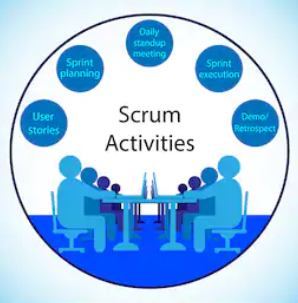Have you ever wondered how decisions are made in the Scrum
project? Empirical Process Control These are made usually upon experiments and observation
instead of upfront planning. This type of process control relies mainly on lucidity,
inspection and acclimatization.
These are explained in Empirical Process Control brief as follows:
a) Lucidity: With lucidity, anyone can
observe every aspect of the Scrum project. Empirical
Process Control This encourages the easy and transparent information flow
in the entire organization and it creates an open work culture. Transparency is represented using :
·
Relics :
Project vision statement
Set up product backlog
Issue planning schedule
·
Meetings
: Sprint review and daily stand up
·
Information
Radiators : Scrum board and burn
down charts
b) Inspection: This is represented through:
·
Common scrum board as well as other information
radiators.
·
Collect feedback from customer as well as other
stakeholders, create scheduled product backlog, etc.
·
Approve deliverables from the product owner as
well as the customer in demonstrating and validating the sprint process.
c) Acclimatization: This takes place as the Scrum core team and
stake holders learn through lucidity and inspection. Then, they adapt by making
alterations in the work they are doing. In Scrum project, acclimatization is represented
through:
-
Stand up meetings
-
Constant risk identification
-
Change in requests
-
Scrum Guidance Body
-
Retrospect Sprint Meeting
Basically, Empirical
Process Control is used to handle complex processes which are not very well
understood. So, how it is defined?
Empirical Process
is seen as a black box, the outputs are evaluated for its inputs and outputs. We have daily scrums, sprint planning meeting,
review meeting and sprint retrospective. Each sprint retrospective is time boxed,
checkpoints will always occur at a predefined time.
Inspection is done at each check point. This will allow you
to adapt the process with the collected information. Another important aspect is the process model that
is directly derived from the outside. This is the reason there’s no need to add
more backlog items to a sprint as compared to the last sprint.
We All Know Scrum Is
An Empirical Process But Is It A Defined Process?
Defined process is derived from first principles which mean
it must adhere to the laws of the nature as well as other fundamental and
defined laws. Another description is
that in description model, every piece of work is understood.
With a well- defined set of inputs, same set of outputs is
generated every time. In the real world, there will be a variance but to a
minimum. The feedback is not needed because you are aware about what to do
next.
In a nutshell:
Scrum is an Empirical Process. The empirical process control basically
relies on three pillars: Lucidity, Inspection and Acclimatization. To know more
about empirical process control, get in touch with lean agile training.

Nice and good article. It is very useful for me to learn and understand easily. Thanks for sharing your valuable information and time. Please keep updating Devops online training hyderabad
ReplyDeleteTo learn the new way automation for Agile Scrum projects, it is always advisable to have Scrum Master Certification Online or Classroom. You can do Scrum Master Certification in Pune with SarvaShikshan® e-Learning
ReplyDeleteNice post, thanks for sharing...!!
ReplyDeleteAgile Scrum foundation course by MindCypress offers a detailed module which includes Agile methodologies while, explaining the relationship between Scrum and Agile. The module has been designed by highly experienced experts from the industry and they made sure to focus more on the practical approach that will help in implementing Agile and Scrum.